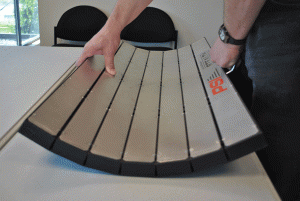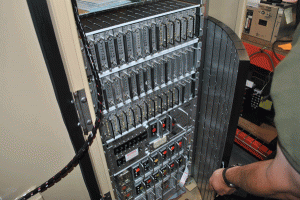Richard Brody, Vice President of Business Development & Strategic Marketing, PowerGenix
When Thomas Edison patented the first Nickel-Zinc (NiZn) battery in 1901, the electrical grid was still in its infancy. Now, 110 years and 32 patents later, NiZn is a mature technology ready to serve critical functions within a rapidly developing smart grid. This diversity of applications can be divided roughly according to the side of the meter on which they fall: the utility side or power consumer side.
The Utility Side of the Meter
Modern utilities are broadening their understanding of energy storage at a rapid pace. Utilities have an impressive 100-year record of reliable service, but the demands placed on them are changing quickly. With growing demand, stronger emissions standards, higher penetration of renewable generation and electric vehicles, as well as the development of a more intelligent grid, utilities increasingly require energy storage at the points of generation, transmission and last mile facilities such as substations. NiZn works well in all three areas, excelling at providing backup power to substations, offering area regulation services and enabling utilities to defer transmission and distribution (T&D) upgrades.
To maintain high system reliability, utilities must ensure that their equipment, especially substations, continues to function during a blackout or brownout. To this end, most utilities use a DC-based backup power source, traditionally lead-acid batteries operating at 125 V, 60 A peak and 50 Ah. But lead-acid, the traditional chemistry for substation backup, requires extensive maintenance, effectively doubling the cost of battery ownership over its expected life. NiZn batteries meet the performance needs of substation backup with no maintenance needs, offering clear lifetime cost advantages over lead-acid. NiZn’s small size (half the size and weight of lead-acid) is a further advantage.
Area regulation, in which energy storage is used to reconcile momentary differences between power supply and demand, is another exciting arena for NiZn, especially as regulatory barriers have become more flexible in recent years. Theoretically, area regulation batteries can be located anywhere within a power system. The most likely physical configuration would be megawatt-scale batteries at sub-transmission or higher voltage distribution facilities. Area regulation would typically call for about 15 minutes of discharge at 480 V. Other energy storage technologies used for this purpose are significantly more expensive and potentially dangerous, so NiZn’s cost and safety record make it appealing for area regulation.
NiZn is also a boon to utilities in that it allows them to defer installation of power line, substation or generation upgrades. Such upgrades are especially challenging given the uncertainties faced by grid planners bringing on renewable generation, as well as permitting challenges inherent in building transmission, distribution and generation assets. For these applications, lightweight NiZn batteries could be mounted on movable trailers so their services could be located as needed within a power grid. The high-energy nature of this duty matches NiZn capabilities closely, and utility planners find the chemistry appealing for its low-maintenance, non-toxic characteristics. In this case, NiZn batteries would be expected to discharge for three to six hours within the 460 to 800 V DC range.
Finally, NiZn finds applications in grid ancillary services, particularly frequency and voltage regulation, where the chemistry’s high power capabilities are particularly well suited. Since ancillary services installations are deployed in a highly distributed manner, NiZn’s lack of maintenance requirements and size and weight advantages can deliver significant cost savings for utilities. For these applications, capacity and voltage ratings would vary widely.
Power Consumer Side of the Meter

On the other side of the meter, at stationary points of electricity consumption, NiZn also finds exciting applications. Its power density allows for small form factors in applications, such as uninterruptible power supply (UPS) for telecom, traffic control, and other functions, in which space is precious.
For example, PSI Acquisition, a traffic control equipment provider, recently incorporated PowerGenix NiZn batteries into its UPS for traffic light control systems, in which uninterrupted power can literally be a matter of life or death. Because of their high power density, NiZn batteries enabled design of a new UPS that could fit within previously wasted space in traffic lighting control cabinets. This eliminates the need for an extra “piggyback” battery cabinet to accompany traffic light controls. NiZn’s maintenance-free nature and longer calendar life is also appealing for this application.
Since traffic light backups are often situated in neighborhoods, removing potentially dangerous lead-acid batteries brings important public safety benefits. In addition, the inherent safety of a water-based electrolyte such as that found in NiZn batteries, in contrast to the flammable, organic electrolytes in other advanced chemistries, is another major advantage.
PSI Acquisition’s NiZn-powered product, UP-Stealth, allows traffic agencies to reduce maintenance and installation costs while enhancing traffic safety. Since the US has more than 300,000 intersections with traffic lights, the market opportunity is sizeable.
According to PSI Acquisition CEO Tim Hysell, “PowerGenix’s NiZn rechargeable chemistry enabled us to create a lighter, higher-performing, hazard-free and more reliable product that will make intersections safer.”

In telecom, NiZn is also an appealing alternative to traditional lead-acid batteries since it takes up so little space. In data centers, any space taken up by UPS is space that cannot be used for servers, switches and other revenue-generating equipment. In other words, space is money. By offering a smaller form factor than traditional lead-acid batteries, NiZn batteries enable telecom companies to grow their bottom line. Furthermore, since telecom backup sometimes occurs in places with extreme ambient temperatures, NiZn’s ability to perform amid a wide range of temperatures is key.
NiZn is well suited to provide larger-scale onsite backups to commercial and industrial customers. Commercial and industrial facilities traditionally relied on lead-acid batteries to provide a short supply of power during an outage, thereby allowing an entire facility to maintain power until fossil-based generation came online. NiZn can be a more a effective and reliable replacement for lead-acid in these applications as well.
Finally, NiZn can support commercial and industrial site energy needs by providing power quality support. Since utilities are largely focused on preventing power interruptions longer than five minutes, customers more often see shorter-duration power quality problems. As such, NiZn batteries can react to short-term interruptions of service ranging from tenths of a second to several minutes, protecting facilities from dips or swells in voltage.
Conclusions
While NiZn has great potential for stationary storage, some barriers to market penetration do exist. Stationary storage based on advanced battery chemistries is a new market, and customers are evaluating and starting to test a variety of solutions. However, given NiZn’s cost, performance, safety and operational advantages, we will likely see Edison’s original battery chemistry proliferate throughout our power generation and transmission infrastructure.
For more information, please visit PowerGenix at www.powergenix.com.
This article was printed the September/October 2011 issue of Battery Power magazine.







